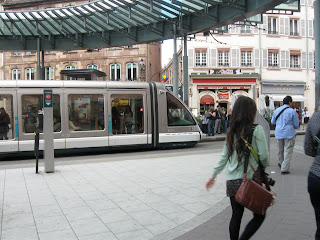Today instead of venturing out into Strasbourg, we had Strasbourg come to us! A man by the name of Mikael Lux came to the Chateau as a representative of the city, and was the person in charge of "mission plan climate."Project eco-city: a project based on three frames: blue infrastructure (waterways), green infrastructure, and public transport infrastructure.
Climate Plan:
To reduce greenhouse emission in order to limit climate change. A climate fund has been created out of 1% of the domestic budget which is 13.5 million euros per year. In order to reduce CO2, action needs to happen on 3 scales: internally, externally, and globally. So far, Strasbourg is on the right track to reduce CO2. An inhabitant in Strasbourg produces 7.2 tons of CO2 per year versus 14-17 tons of CO2 per inhabitant in the United States. Planning around historic buildings is a major problem for the city, and the energy for these buildings is the biggest carbon print for Strasbourg, therefore building renovation is necessary to reduce energy waste. The implementation of the climate plan includes: construction and renovation of low energy buildings, sustainable mobility, land an urban planning, and biodiversity.
Transportation Policy:
Currently, 50% of Strasbourg's residents use transportation other than cars (not including freight), and city planners are hoping to increase this number. The current tram line began in 1994; there are currently 14.8km of tram line total, and the next step is to connect this to Germany's tram system. In the beginning of the tram, the French government paid 20-40% of investment, but now they only pay 10%. The investment comes from local tax industry, collectivities from the public, and the remaining amount is from customers. The taxes used for public transportation don't come from the city alone; they are expanded to the 28 cities in the urban network around Strasbourg.
The main ideas to improve the transit system include: developing public transport around the tram network, reducing traffic in and towards the downtown area, and establishing bypass roads to reduce traffic transit. The city is able to limit traffic into downtown by putting in parking garages around the outskirt of the city that connect to free public transport, adding more pedestrian and bicycle areas, and charging a high hourly rate to park cars. A large portion of the city budget is also dedicated to buying up parking lots and converting them into more usable space. 25 car sharing stations also exist in the city. All of the transit modification preserve the historical city center while still encouraging tourism by preventing cars from coming downtown and building radial transport to connect cities outside downtown.
After the presentation at the Chateau, we traveled into downtown Strasbourg to hear a second presentation from Mr. Beckler, the assistant director of ADIRA - the Agency of Economic Development of the Alsace Region. ADIRA is a 60 year-old nonprofit organization with the goal of attracting and maintaining economic investment in the region for job creation. The Alsace region has one of the highest population densities in France, and is a center of economic strength for the county.
Economic Statistics for the Alsace Region
- 5th highest GDP per person in France
- 3rd highest disposable income per person
- 3rd excellence in public research
- highest ratio of big company presence
- 2nd highest industrial concentration in France
The Alsatian key industries are automotive, agribusiness, plastics, electronics/electricity, and pharmaceutical. They are currently concentrating of development in 3 fields of excellence: vehicle of the future, therapeutic innovation, and fiber (wood and textile). Their reputation for seeking the vehicle of the future is supported by the fact that the region is home to Bugati headquarters. They also have a project with Germany to build three new data centers. Alsace is a very wealthy region, so they do not offer economic incentives to prospective companies. The belief is that if a company comes for a monetary incentive, they will leave for a better on. Alternatively, what the region has to offer serves as an incentive that cannot be duplicated. Benefits of Alsace include: 2 high speed railways, one of the largest universities, a higher quality of life (over 250 museums, bike paths, famous food and wine).
After the presentation we had free time to enjoy our last day in the city, so a group of us walked through Petite France, which is the oldest part of the city. We walked lazily while enjoying the view, taking pictures, and dodging into small shops to look at souvenirs before heading back to the Chateau for our last dinner there.
Peace, Love, and Strasbourg ~ Naomi
Pictures of the Day
View of Strasbourg from the window of ADIRA presentation
Cool looking train stop in the city
High speed rail!
Hippies, gotta love 'em
Archer's tower in Petite France
Houses on the river
View of Petite France
Age of the buildings









No comments:
Post a Comment